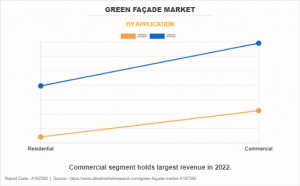Green Facade Market Expected to Reach $1485 Million by 2032
WILMINGTON, DELAWARE, UNITED STATES, January 19, 2024 /EINPresswire.com/ -- As per the latest report by Allied Market Research titled "Green Facade Market," the market size for green facades reached $662.2 million in 2020 and is anticipated to achieve $1485 million by 2032, exhibiting a compound annual growth rate (CAGR) of 7.2% from 2023 to 2032.
Get PDF Report on Email: https://www.alliedmarketresearch.com/request-sample/197776
Green facades involve cultivating plants on vertical surfaces of buildings or structures, serving as aesthetically pleasing organic coverings. These vertical gardens can be installed on exterior or interior walls, as well as self-supporting structures, with a framework supporting soil or growing medium for various plant types.
Green facades refer to architectural elements involving the cultivation of plants on vertical surfaces of a building or structure. These vertical gardens can be affixed to exterior or interior walls, as well as freestanding infrastructures, creating a vibrant and living covering. To support a variety of plant types, green facades typically incorporate a framework or support system that securely holds the soil or growing medium.
aesthetic sustainability and functionality of existing buildings. Forecasts indicate a growth in house remodeling and repair expenditures, with a 4% rise in remodeling expenditure on owner-occupied single-family homes in 2021 and an additional 2% increase in 2022.
Buy This Report: https://www.alliedmarketresearch.com/checkout-final/95dd618d47e764e2ad4219b604d8b5d9
The rising focus on environmental sustainability and the use of eco-friendly building materials contribute to the growth of the green walls market. Moreover, green facades enhance the visual appeal of shopping malls and retail spaces, attracting footfall and improving the overall shopping experience. Government initiatives, such as the $1.5 trillion investment agenda by the Government of India in commercial construction sectors until 2025, particularly in schools, higher education, health, sports, and basic infrastructure, create opportunities for green facade market manufacturers. Therefore, the green facade industry is expected to witness lucrative growth during the forecast period.
Over the past decade, there has been a growing awareness of the advantages of green architecture, presenting a fresh perspective on addressing the urban heat island issue. Consequently, the integration of these eco-friendly solutions into buildings has become a crucial element, serving to restore balance and rescue the urban environment.
The advantage is its ability to occupy minimal space within a densely populated metropolitan area while offering several vertical meters of greenery. However, it's crucial to note that a climbing plant capable of covering a five-story building within a few years needs sufficient space for its roots to maintain good health. While the plant doesn't need a substantial ground area, it does require some underground space to support its root system and ensure healthy growth
Inquire Before Buying: https://www.alliedmarketresearch.com/purchase-enquiry/197776
The growing adoption of green facades is propelled by increasing public awareness of environmental issues and the demand for sustainable practices. The rapid expansion of urban areas has led to reduced green spaces and higher construction densities. For example, the real estate industry in India is expected to grow from $1.72 billion in 2019 to $9.30 billion by 2040, with the overall sector expanding from $200 billion in 2021 to $1 trillion in 2030, representing 13% of the GDP by 2025. Sectors like retail, hospitality, and commercial real estate are witnessing significant growth, contributing to the rising demand for infrastructure. Integrating green facades into urban environments addresses this issue without utilizing valuable ground space, simultaneously reducing the carbon impact of buildings through enhanced energy efficiency, decreased heat absorption, and the promotion of urban biodiversity. Consequently, these advantages are anticipated to drive the growth of the green facade market.
Nevertheless, selecting the right plant species for green facades is crucial and can pose challenges. Factors such as climate, sunlight availability, and the local environment influence plant selection. Incorrect choices may lead to poor performance or maintenance issues, potentially impacting the market share during the forecast period.
Additionally, the robust housing market, characterized by increased home building, sales, and home equity, continues to support the renovation industry. Homeowners, as the economy improves, are expected to invest in larger discretionary home renovations. Green facades are increasingly employed in remodeling and retrofitting to enhance the
Benefits of green facade:
Enhance urban climate:
In densely populated urban areas, green walls can serve as a solution to the scarcity of garden spaces by aiding in the reduction of the urban heat island effect. This effect arises due to the substitution of green areas with solid surfaces, causing sunlight to be converted into heat. Thoughtful design and construction of green facades facilitate the cooling of buildings, capture rainwater, purify the air by filtering pollutants, and contribute to reducing cooling expenses.
Better air quality:
Through photosynthesis, green facades produce oxygen, effectively refreshing and purifying the air within buildings. Moreover, these plants release water vapor via their leaves, leading to increased humidity levels and creating an overall improved climate within the building environment.
David Correa
Allied Analytics LLP
+ + +1 800-792-5285
email us here
Visit us on social media:
Facebook
Twitter
LinkedIn


